Taras Hryhorovych Shevchenko The greatest writer of Ukraine
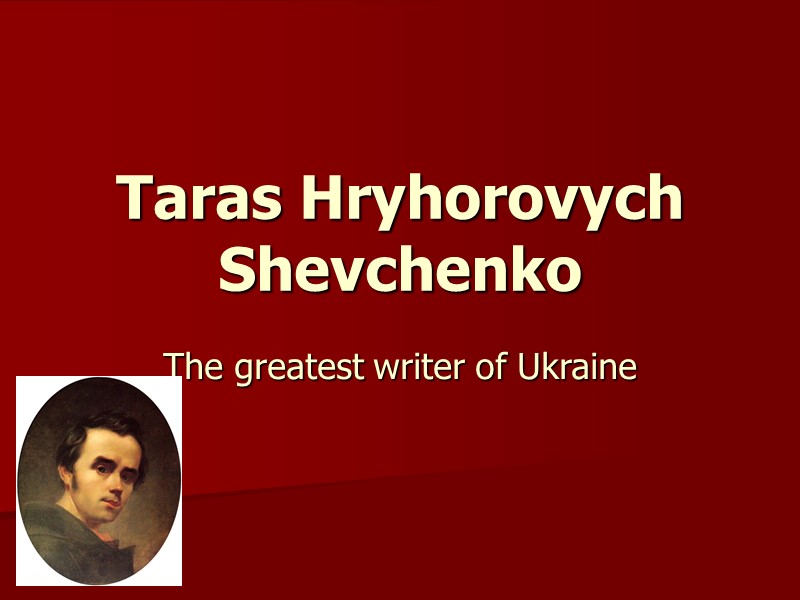
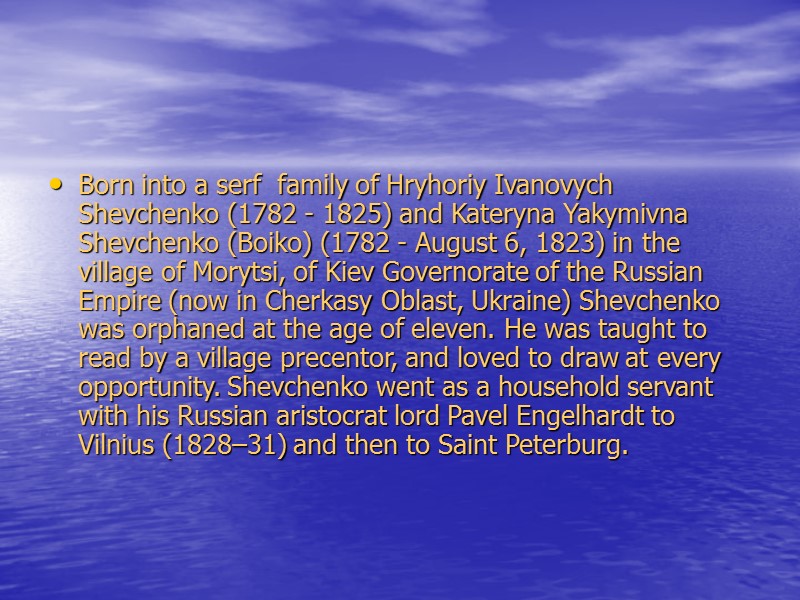
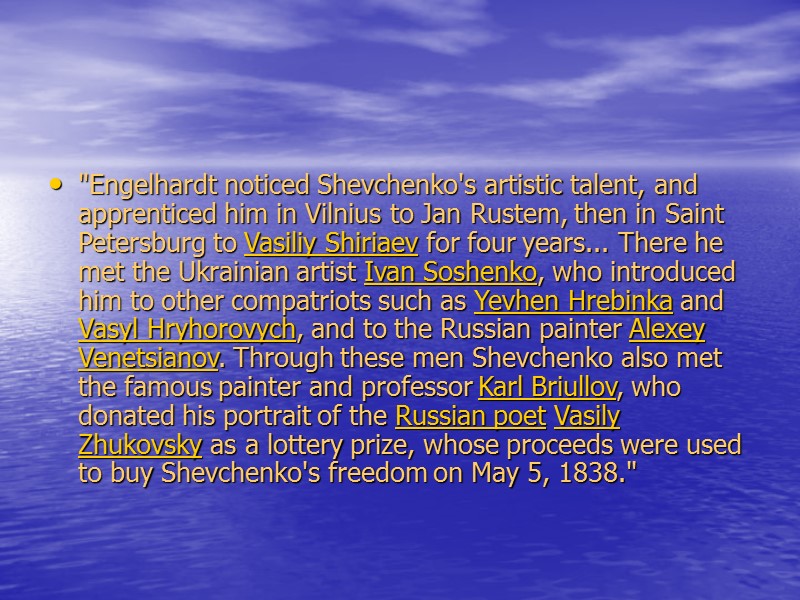
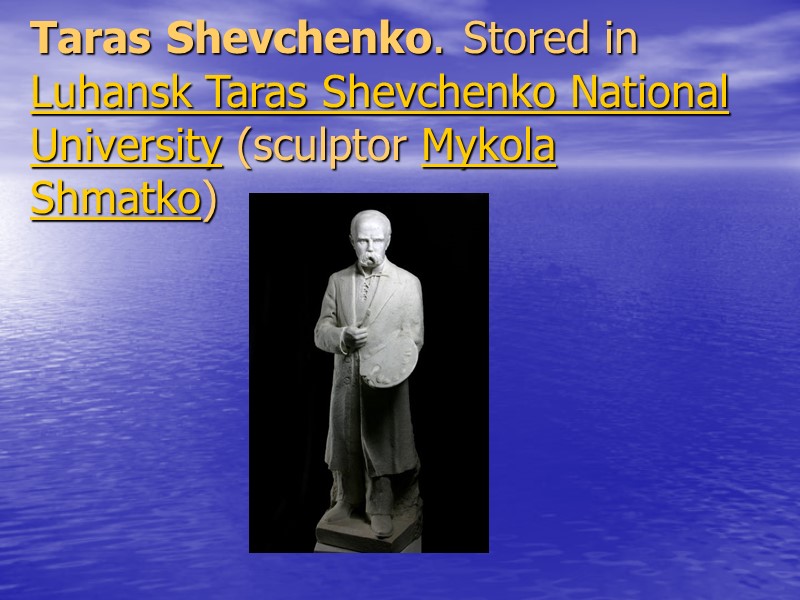
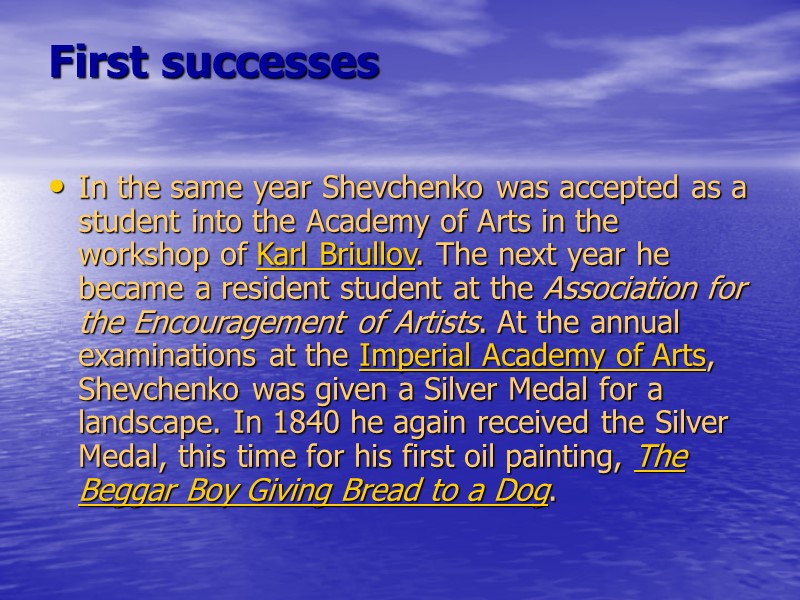
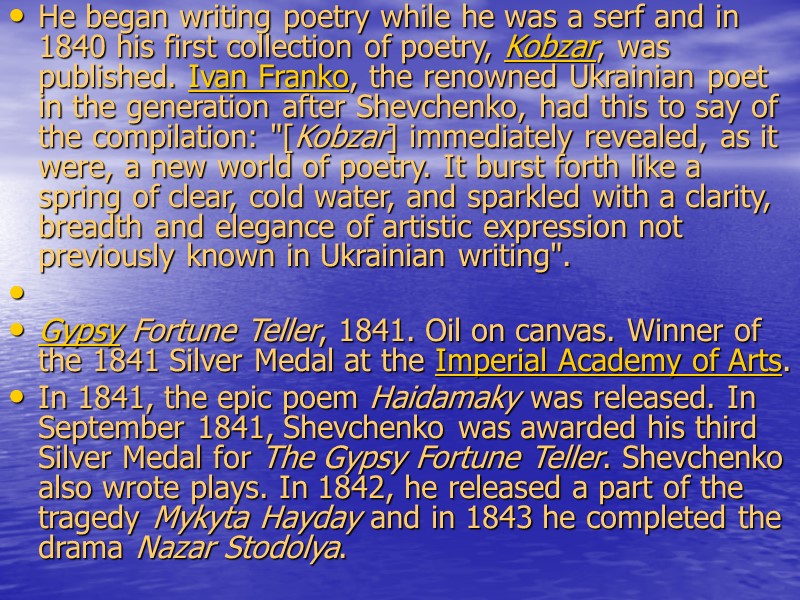
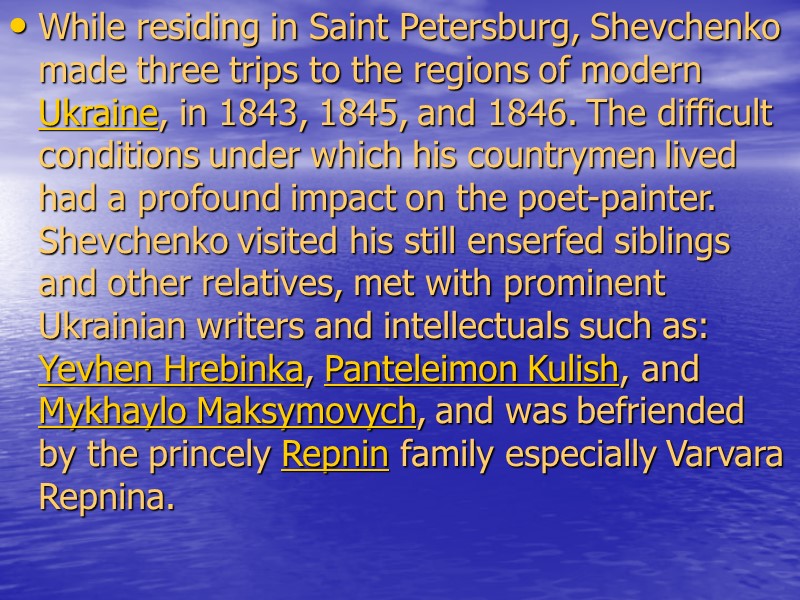
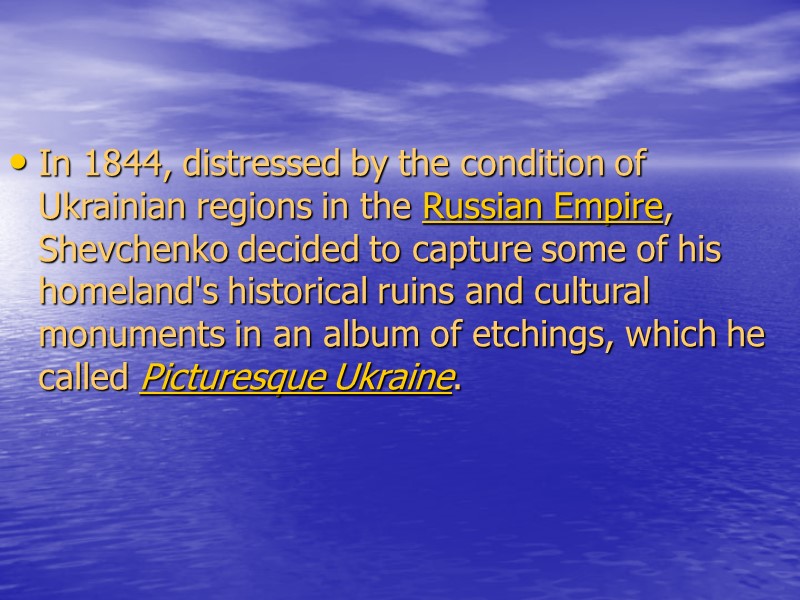
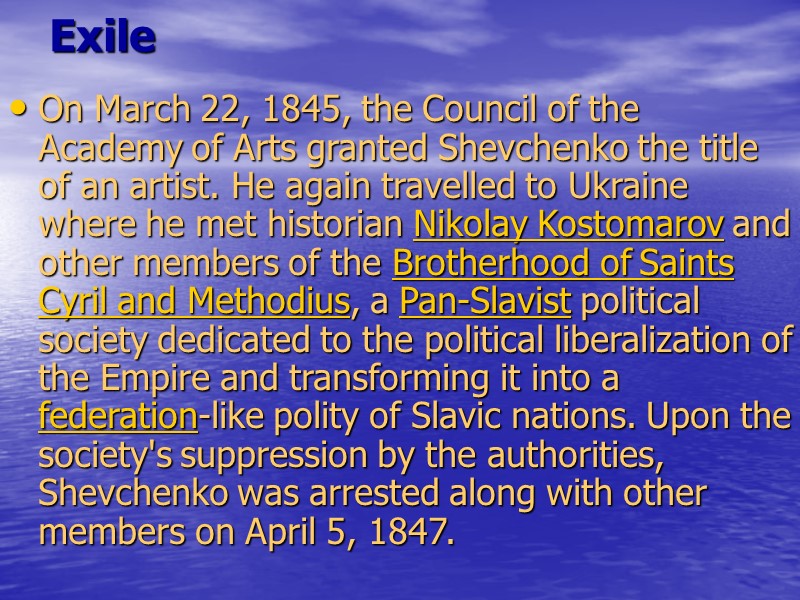
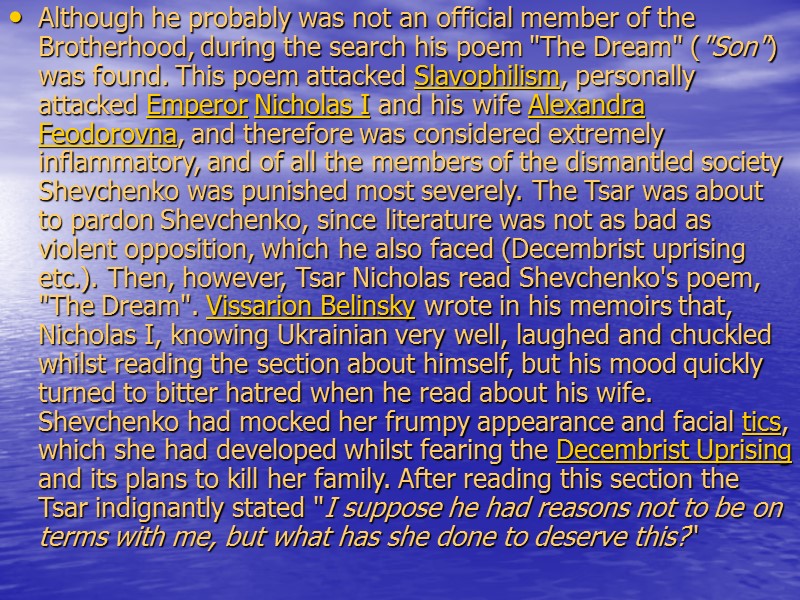
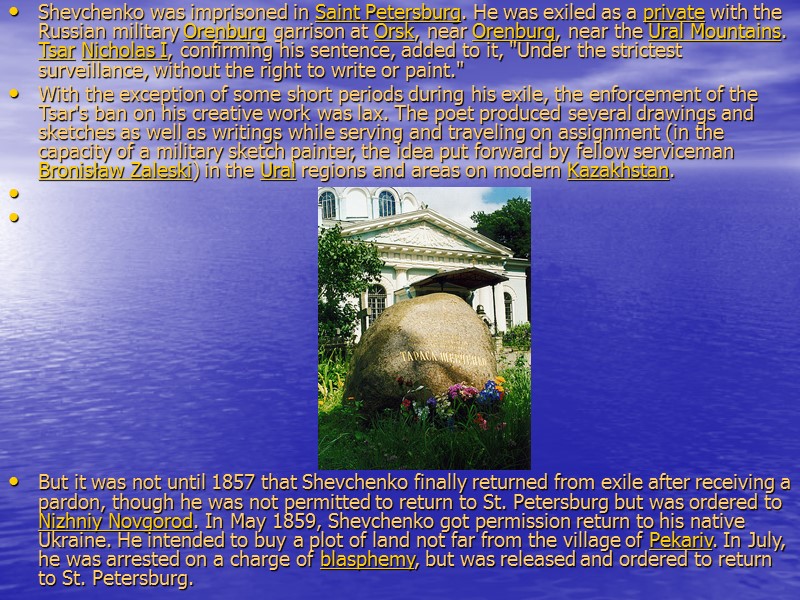
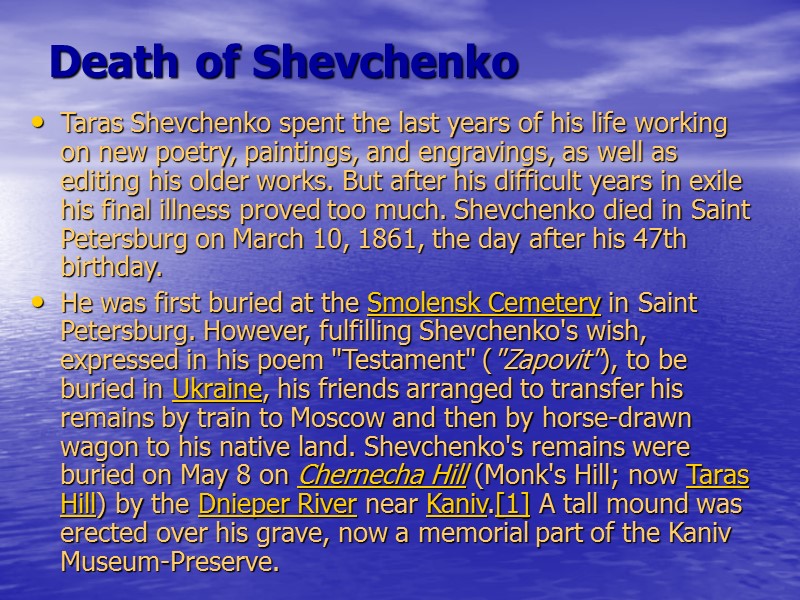
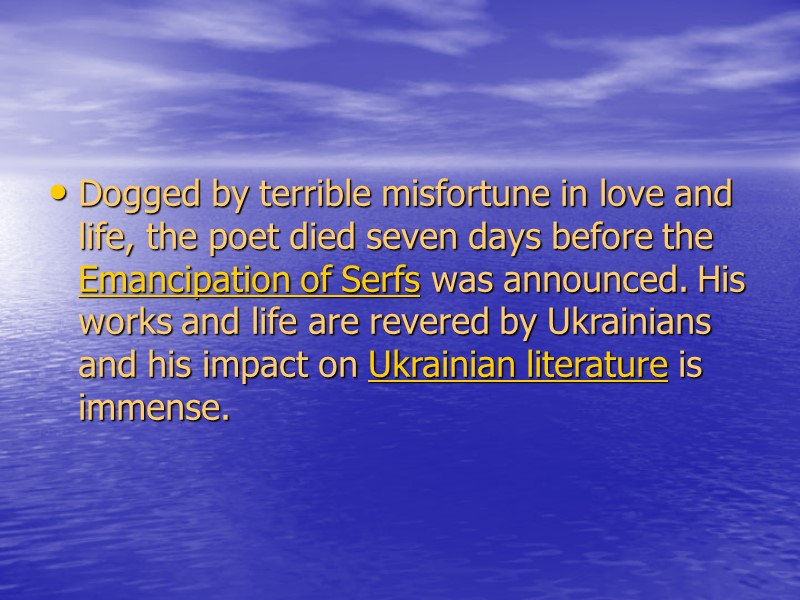
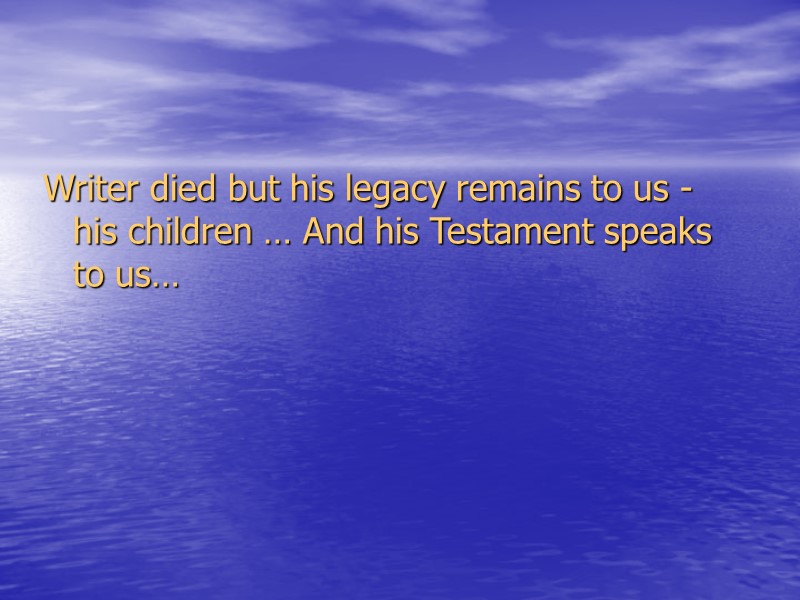
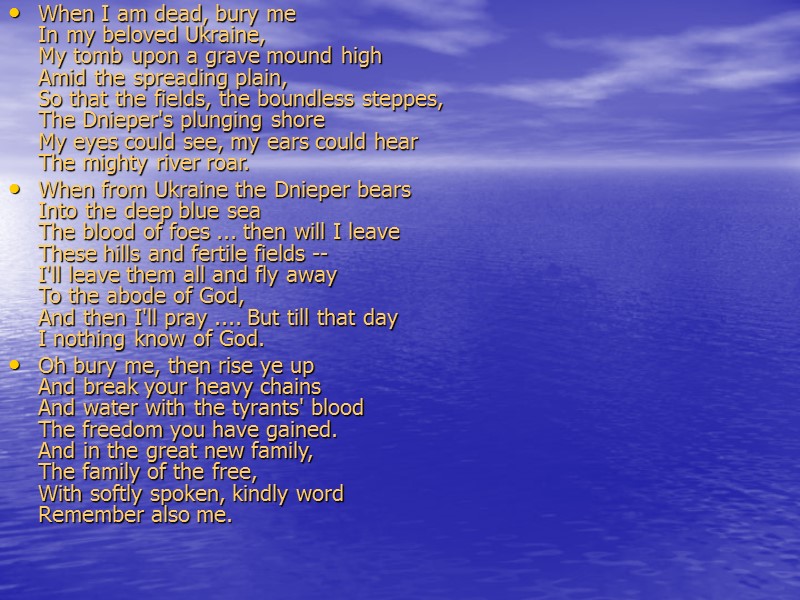
25336-taras_hryhorovych_shevchenko.ppt
- Количество слайдов: 15
 Taras Hryhorovych Shevchenko The greatest writer of Ukraine
Taras Hryhorovych Shevchenko The greatest writer of Ukraine
 Born into a serf family of Hryhoriy Ivanovych Shevchenko (1782 - 1825) and Kateryna Yakymivna Shevchenko (Boiko) (1782 - August 6, 1823) in the village of Morytsi, of Kiev Governorate of the Russian Empire (now in Cherkasy Oblast, Ukraine) Shevchenko was orphaned at the age of eleven. He was taught to read by a village precentor, and loved to draw at every opportunity. Shevchenko went as a household servant with his Russian aristocrat lord Pavel Engelhardt to Vilnius (1828–31) and then to Saint Peterburg.
Born into a serf family of Hryhoriy Ivanovych Shevchenko (1782 - 1825) and Kateryna Yakymivna Shevchenko (Boiko) (1782 - August 6, 1823) in the village of Morytsi, of Kiev Governorate of the Russian Empire (now in Cherkasy Oblast, Ukraine) Shevchenko was orphaned at the age of eleven. He was taught to read by a village precentor, and loved to draw at every opportunity. Shevchenko went as a household servant with his Russian aristocrat lord Pavel Engelhardt to Vilnius (1828–31) and then to Saint Peterburg.
 "Engelhardt noticed Shevchenko's artistic talent, and apprenticed him in Vilnius to Jan Rustem, then in Saint Petersburg to Vasiliy Shiriaev for four years... There he met the Ukrainian artist Ivan Soshenko, who introduced him to other compatriots such as Yevhen Hrebinka and Vasyl Hryhorovych, and to the Russian painter Alexey Venetsianov. Through these men Shevchenko also met the famous painter and professor Karl Briullov, who donated his portrait of the Russian poet Vasily Zhukovsky as a lottery prize, whose proceeds were used to buy Shevchenko's freedom on May 5, 1838."
"Engelhardt noticed Shevchenko's artistic talent, and apprenticed him in Vilnius to Jan Rustem, then in Saint Petersburg to Vasiliy Shiriaev for four years... There he met the Ukrainian artist Ivan Soshenko, who introduced him to other compatriots such as Yevhen Hrebinka and Vasyl Hryhorovych, and to the Russian painter Alexey Venetsianov. Through these men Shevchenko also met the famous painter and professor Karl Briullov, who donated his portrait of the Russian poet Vasily Zhukovsky as a lottery prize, whose proceeds were used to buy Shevchenko's freedom on May 5, 1838."
 Taras Shevchenko. Stored in Luhansk Taras Shevchenko National University (sculptor Mykola Shmatko)
Taras Shevchenko. Stored in Luhansk Taras Shevchenko National University (sculptor Mykola Shmatko)
 First successes In the same year Shevchenko was accepted as a student into the Academy of Arts in the workshop of Karl Briullov. The next year he became a resident student at the Association for the Encouragement of Artists. At the annual examinations at the Imperial Academy of Arts, Shevchenko was given a Silver Medal for a landscape. In 1840 he again received the Silver Medal, this time for his first oil painting, The Beggar Boy Giving Bread to a Dog.
First successes In the same year Shevchenko was accepted as a student into the Academy of Arts in the workshop of Karl Briullov. The next year he became a resident student at the Association for the Encouragement of Artists. At the annual examinations at the Imperial Academy of Arts, Shevchenko was given a Silver Medal for a landscape. In 1840 he again received the Silver Medal, this time for his first oil painting, The Beggar Boy Giving Bread to a Dog.
 He began writing poetry while he was a serf and in 1840 his first collection of poetry, Kobzar, was published. Ivan Franko, the renowned Ukrainian poet in the generation after Shevchenko, had this to say of the compilation: "[Kobzar] immediately revealed, as it were, a new world of poetry. It burst forth like a spring of clear, cold water, and sparkled with a clarity, breadth and elegance of artistic expression not previously known in Ukrainian writing". Gypsy Fortune Teller, 1841. Oil on canvas. Winner of the 1841 Silver Medal at the Imperial Academy of Arts. In 1841, the epic poem Haidamaky was released. In September 1841, Shevchenko was awarded his third Silver Medal for The Gypsy Fortune Teller. Shevchenko also wrote plays. In 1842, he released a part of the tragedy Mykyta Hayday and in 1843 he completed the drama Nazar Stodolya.
He began writing poetry while he was a serf and in 1840 his first collection of poetry, Kobzar, was published. Ivan Franko, the renowned Ukrainian poet in the generation after Shevchenko, had this to say of the compilation: "[Kobzar] immediately revealed, as it were, a new world of poetry. It burst forth like a spring of clear, cold water, and sparkled with a clarity, breadth and elegance of artistic expression not previously known in Ukrainian writing". Gypsy Fortune Teller, 1841. Oil on canvas. Winner of the 1841 Silver Medal at the Imperial Academy of Arts. In 1841, the epic poem Haidamaky was released. In September 1841, Shevchenko was awarded his third Silver Medal for The Gypsy Fortune Teller. Shevchenko also wrote plays. In 1842, he released a part of the tragedy Mykyta Hayday and in 1843 he completed the drama Nazar Stodolya.
 While residing in Saint Petersburg, Shevchenko made three trips to the regions of modern Ukraine, in 1843, 1845, and 1846. The difficult conditions under which his countrymen lived had a profound impact on the poet-painter. Shevchenko visited his still enserfed siblings and other relatives, met with prominent Ukrainian writers and intellectuals such as: Yevhen Hrebinka, Panteleimon Kulish, and Mykhaylo Maksymovych, and was befriended by the princely Repnin family especially Varvara Repnina.
While residing in Saint Petersburg, Shevchenko made three trips to the regions of modern Ukraine, in 1843, 1845, and 1846. The difficult conditions under which his countrymen lived had a profound impact on the poet-painter. Shevchenko visited his still enserfed siblings and other relatives, met with prominent Ukrainian writers and intellectuals such as: Yevhen Hrebinka, Panteleimon Kulish, and Mykhaylo Maksymovych, and was befriended by the princely Repnin family especially Varvara Repnina.
 In 1844, distressed by the condition of Ukrainian regions in the Russian Empire, Shevchenko decided to capture some of his homeland's historical ruins and cultural monuments in an album of etchings, which he called Picturesque Ukraine.
In 1844, distressed by the condition of Ukrainian regions in the Russian Empire, Shevchenko decided to capture some of his homeland's historical ruins and cultural monuments in an album of etchings, which he called Picturesque Ukraine.
 Exile On March 22, 1845, the Council of the Academy of Arts granted Shevchenko the title of an artist. He again travelled to Ukraine where he met historian Nikolay Kostomarov and other members of the Brotherhood of Saints Cyril and Methodius, a Pan-Slavist political society dedicated to the political liberalization of the Empire and transforming it into a federation-like polity of Slavic nations. Upon the society's suppression by the authorities, Shevchenko was arrested along with other members on April 5, 1847.
Exile On March 22, 1845, the Council of the Academy of Arts granted Shevchenko the title of an artist. He again travelled to Ukraine where he met historian Nikolay Kostomarov and other members of the Brotherhood of Saints Cyril and Methodius, a Pan-Slavist political society dedicated to the political liberalization of the Empire and transforming it into a federation-like polity of Slavic nations. Upon the society's suppression by the authorities, Shevchenko was arrested along with other members on April 5, 1847.
 Although he probably was not an official member of the Brotherhood, during the search his poem "The Dream" ("Son") was found. This poem attacked Slavophilism, personally attacked Emperor Nicholas I and his wife Alexandra Feodorovna, and therefore was considered extremely inflammatory, and of all the members of the dismantled society Shevchenko was punished most severely. The Tsar was about to pardon Shevchenko, since literature was not as bad as violent opposition, which he also faced (Decembrist uprising etc.). Then, however, Tsar Nicholas read Shevchenko's poem, "The Dream". Vissarion Belinsky wrote in his memoirs that, Nicholas I, knowing Ukrainian very well, laughed and chuckled whilst reading the section about himself, but his mood quickly turned to bitter hatred when he read about his wife. Shevchenko had mocked her frumpy appearance and facial tics, which she had developed whilst fearing the Decembrist Uprising and its plans to kill her family. After reading this section the Tsar indignantly stated "I suppose he had reasons not to be on terms with me, but what has she done to deserve this?"
Although he probably was not an official member of the Brotherhood, during the search his poem "The Dream" ("Son") was found. This poem attacked Slavophilism, personally attacked Emperor Nicholas I and his wife Alexandra Feodorovna, and therefore was considered extremely inflammatory, and of all the members of the dismantled society Shevchenko was punished most severely. The Tsar was about to pardon Shevchenko, since literature was not as bad as violent opposition, which he also faced (Decembrist uprising etc.). Then, however, Tsar Nicholas read Shevchenko's poem, "The Dream". Vissarion Belinsky wrote in his memoirs that, Nicholas I, knowing Ukrainian very well, laughed and chuckled whilst reading the section about himself, but his mood quickly turned to bitter hatred when he read about his wife. Shevchenko had mocked her frumpy appearance and facial tics, which she had developed whilst fearing the Decembrist Uprising and its plans to kill her family. After reading this section the Tsar indignantly stated "I suppose he had reasons not to be on terms with me, but what has she done to deserve this?"
 Shevchenko was imprisoned in Saint Petersburg. He was exiled as a private with the Russian military Orenburg garrison at Orsk, near Orenburg, near the Ural Mountains. Tsar Nicholas I, confirming his sentence, added to it, "Under the strictest surveillance, without the right to write or paint." With the exception of some short periods during his exile, the enforcement of the Tsar's ban on his creative work was lax. The poet produced several drawings and sketches as well as writings while serving and traveling on assignment (in the capacity of a military sketch painter, the idea put forward by fellow serviceman Bronisław Zaleski) in the Ural regions and areas on modern Kazakhstan. But it was not until 1857 that Shevchenko finally returned from exile after receiving a pardon, though he was not permitted to return to St. Petersburg but was ordered to Nizhniy Novgorod. In May 1859, Shevchenko got permission return to his native Ukraine. He intended to buy a plot of land not far from the village of Pekariv. In July, he was arrested on a charge of blasphemy, but was released and ordered to return to St. Petersburg.
Shevchenko was imprisoned in Saint Petersburg. He was exiled as a private with the Russian military Orenburg garrison at Orsk, near Orenburg, near the Ural Mountains. Tsar Nicholas I, confirming his sentence, added to it, "Under the strictest surveillance, without the right to write or paint." With the exception of some short periods during his exile, the enforcement of the Tsar's ban on his creative work was lax. The poet produced several drawings and sketches as well as writings while serving and traveling on assignment (in the capacity of a military sketch painter, the idea put forward by fellow serviceman Bronisław Zaleski) in the Ural regions and areas on modern Kazakhstan. But it was not until 1857 that Shevchenko finally returned from exile after receiving a pardon, though he was not permitted to return to St. Petersburg but was ordered to Nizhniy Novgorod. In May 1859, Shevchenko got permission return to his native Ukraine. He intended to buy a plot of land not far from the village of Pekariv. In July, he was arrested on a charge of blasphemy, but was released and ordered to return to St. Petersburg.
 Death of Shevchenko Taras Shevchenko spent the last years of his life working on new poetry, paintings, and engravings, as well as editing his older works. But after his difficult years in exile his final illness proved too much. Shevchenko died in Saint Petersburg on March 10, 1861, the day after his 47th birthday. He was first buried at the Smolensk Cemetery in Saint Petersburg. However, fulfilling Shevchenko's wish, expressed in his poem "Testament" ("Zapovit"), to be buried in Ukraine, his friends arranged to transfer his remains by train to Moscow and then by horse-drawn wagon to his native land. Shevchenko's remains were buried on May 8 on Chernecha Hill (Monk's Hill; now Taras Hill) by the Dnieper River near Kaniv.[1] A tall mound was erected over his grave, now a memorial part of the Kaniv Museum-Preserve.
Death of Shevchenko Taras Shevchenko spent the last years of his life working on new poetry, paintings, and engravings, as well as editing his older works. But after his difficult years in exile his final illness proved too much. Shevchenko died in Saint Petersburg on March 10, 1861, the day after his 47th birthday. He was first buried at the Smolensk Cemetery in Saint Petersburg. However, fulfilling Shevchenko's wish, expressed in his poem "Testament" ("Zapovit"), to be buried in Ukraine, his friends arranged to transfer his remains by train to Moscow and then by horse-drawn wagon to his native land. Shevchenko's remains were buried on May 8 on Chernecha Hill (Monk's Hill; now Taras Hill) by the Dnieper River near Kaniv.[1] A tall mound was erected over his grave, now a memorial part of the Kaniv Museum-Preserve.
 Dogged by terrible misfortune in love and life, the poet died seven days before the Emancipation of Serfs was announced. His works and life are revered by Ukrainians and his impact on Ukrainian literature is immense.
Dogged by terrible misfortune in love and life, the poet died seven days before the Emancipation of Serfs was announced. His works and life are revered by Ukrainians and his impact on Ukrainian literature is immense.
 Writer died but his legacy remains to us - his children … And his Testament speaks to us…
Writer died but his legacy remains to us - his children … And his Testament speaks to us…
 When I am dead, bury me In my beloved Ukraine, My tomb upon a grave mound high Amid the spreading plain, So that the fields, the boundless steppes, The Dnieper's plunging shore My eyes could see, my ears could hear The mighty river roar. When from Ukraine the Dnieper bears Into the deep blue sea The blood of foes ... then will I leave These hills and fertile fields -- I'll leave them all and fly away To the abode of God, And then I'll pray .... But till that day I nothing know of God. Oh bury me, then rise ye up And break your heavy chains And water with the tyrants' blood The freedom you have gained. And in the great new family, The family of the free, With softly spoken, kindly word Remember also me.
When I am dead, bury me In my beloved Ukraine, My tomb upon a grave mound high Amid the spreading plain, So that the fields, the boundless steppes, The Dnieper's plunging shore My eyes could see, my ears could hear The mighty river roar. When from Ukraine the Dnieper bears Into the deep blue sea The blood of foes ... then will I leave These hills and fertile fields -- I'll leave them all and fly away To the abode of God, And then I'll pray .... But till that day I nothing know of God. Oh bury me, then rise ye up And break your heavy chains And water with the tyrants' blood The freedom you have gained. And in the great new family, The family of the free, With softly spoken, kindly word Remember also me.
